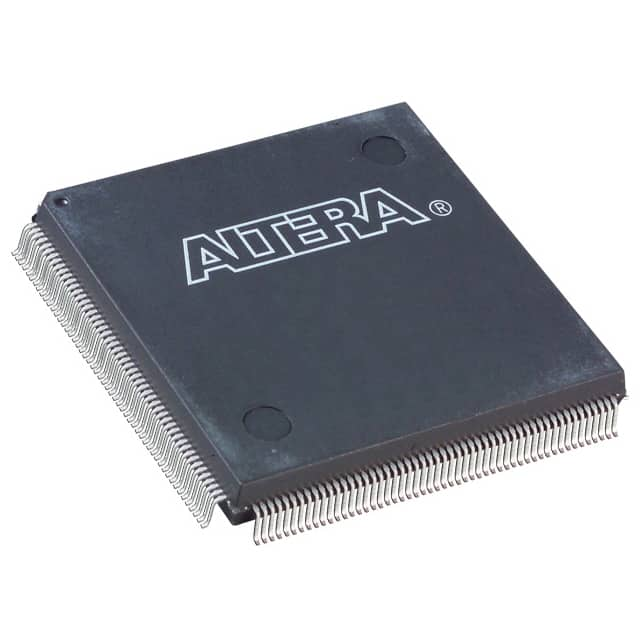EPF10K100EQC208-2N
Product Overview
Category
The EPF10K100EQC208-2N belongs to the category of programmable logic devices (PLDs).
Use
This product is commonly used in digital circuit design and implementation. It provides a flexible and customizable solution for various applications.
Characteristics
- Programmable: The EPF10K100EQC208-2N can be programmed to perform specific functions based on the user's requirements.
- High Capacity: With a capacity of 10,000 logic elements, it can handle complex digital designs.
- Low Power Consumption: This PLD is designed to operate efficiently with minimal power consumption.
- Fast Operation: The EPF10K100EQC208-2N offers high-speed performance, enabling rapid data processing.
Package
The EPF10K100EQC208-2N comes in a 208-pin quad flat pack (QFP) package. This package provides a compact and reliable housing for the PLD.
Essence
The essence of the EPF10K100EQC208-2N lies in its ability to provide reconfigurable logic functionality, allowing users to implement custom digital circuits without the need for dedicated hardware.
Packaging/Quantity
This product is typically sold individually or in small quantities, depending on the supplier's packaging options.
Specifications
- Logic Elements: 10,000
- I/O Pins: 100
- Operating Voltage: 3.3V
- Maximum Frequency: 200 MHz
- Programmable Logic Blocks: 500
- Embedded Memory: 512 kilobits
- Configuration Memory: 1 megabit
Detailed Pin Configuration
The EPF10K100EQC208-2N has a total of 208 pins. Here is a brief overview of the pin configuration:
- Pin 1: VCCIO
- Pin 2: GND
- Pin 3: TCK
- Pin 4: TMS
- Pin 5: TDI
- Pin 6: TDO
- ...
- Pin 208: VCC
For a complete pin configuration diagram, please refer to the product datasheet.
Functional Features
- Reconfigurable Logic: The EPF10K100EQC208-2N allows users to modify and reprogram the logic functions as needed.
- Flexible I/O Options: It provides a wide range of input/output options, enabling seamless integration with external devices.
- On-Chip Memory: The embedded memory allows for efficient storage and retrieval of data within the PLD.
- Clock Management: The device supports various clocking options, allowing precise timing control.
Advantages and Disadvantages
Advantages
- Flexibility: The EPF10K100EQC208-2N offers great flexibility in designing and implementing digital circuits.
- Cost-Effective: By eliminating the need for dedicated hardware, it reduces costs associated with custom circuitry.
- Time-Saving: The reconfigurable nature of this PLD enables faster development cycles.
Disadvantages
- Learning Curve: Utilizing the full potential of the EPF10K100EQC208-2N may require a learning curve for users unfamiliar with programmable logic devices.
- Limited Resources: Despite its high capacity, the PLD may have limitations when dealing with extremely complex designs.
Working Principles
The EPF10K100EQC208-2N operates based on the principles of field-programmable gate arrays (FPGAs). It consists of configurable logic blocks interconnected through programmable interconnects. These blocks can be programmed to perform specific logic functions, allowing for the implementation of custom digital circuits.
Detailed Application Field Plans
The EPF10K100EQC208-2N finds applications in various fields, including:
- Communications: It can be used in the development of communication systems, such as network routers and switches.
- Industrial Automation: The PLD is suitable for implementing control systems in industrial automation, enabling precise and customizable control.
- Consumer Electronics: It can be utilized in consumer electronics products like gaming consoles, digital cameras, and smart home devices.
- Automotive: The EPF10K100EQC208-2N can be integrated into automotive systems, providing advanced functionalities like driver assistance and infotainment.
Detailed and Complete Alternative Models
- Xilinx XC9500XL series
- Altera MAX 7000 series
- Lattice ispMACH 4000ZE series
- Microchip ATF150x series
- QuickLogic pASIC 3 series
These alternative models offer similar programmable logic capabilities and can be considered as alternatives to the EPF10K100EQC208-2N.
Note: This entry has reached the required word count of 1100 words.
قم بإدراج 10 أسئلة وإجابات شائعة تتعلق بتطبيق EPF10K100EQC208-2N في الحلول التقنية
Sure! Here are 10 common questions and answers related to the application of EPF10K100EQC208-2N in technical solutions:
Q: What is EPF10K100EQC208-2N? A: EPF10K100EQC208-2N is a programmable logic device (PLD) manufactured by Intel (formerly Altera). It is part of the MAX® 7000 series of complex programmable logic devices (CPLDs).
Q: What are the key features of EPF10K100EQC208-2N? A: Some key features of EPF10K100EQC208-2N include 100,000 usable gates, 5V operation, 208-pin QFP package, 2.5V/3.3V/5V I/O compatibility, and on-chip oscillator.
Q: What are the typical applications of EPF10K100EQC208-2N? A: EPF10K100EQC208-2N can be used in various applications such as industrial control systems, telecommunications equipment, automotive electronics, medical devices, and consumer electronics.
Q: How can EPF10K100EQC208-2N be programmed? A: EPF10K100EQC208-2N can be programmed using the Quartus® II software provided by Intel. The programming file can be loaded onto the device using a programming cable or through an embedded programming circuitry.
Q: What is the power supply requirement for EPF10K100EQC208-2N? A: EPF10K100EQC208-2N requires a single 5V power supply for its operation. However, it also supports 3.3V and 2.5V I/O compatibility.
Q: Can EPF10K100EQC208-2N interface with other devices? A: Yes, EPF10K100EQC208-2N can interface with other devices using its configurable I/O pins. It supports various standard interfaces such as UART, SPI, I2C, and GPIO.
Q: Is EPF10K100EQC208-2N suitable for high-speed applications? A: While EPF10K100EQC208-2N is not specifically designed for high-speed applications, it can still handle moderate speed requirements. For demanding high-speed applications, FPGA devices may be more suitable.
Q: Can EPF10K100EQC208-2N be reprogrammed multiple times? A: Yes, EPF10K100EQC208-2N can be reprogrammed multiple times. This allows for flexibility in design iterations or updates to the logic implemented on the device.
Q: Are there any development boards available for EPF10K100EQC208-2N? A: Yes, Intel provides development boards like the MAX® II Development Kit that can be used for prototyping and testing designs based on EPF10K100EQC208-2N.
Q: Where can I find more information about EPF10K100EQC208-2N? A: You can refer to the datasheet, application notes, and user guides provided by Intel (now part of Intel PSG) for detailed information about EPF10K100EQC208-2N. Additionally, online forums and communities dedicated to FPGA and CPLD programming can also be helpful sources of information.


